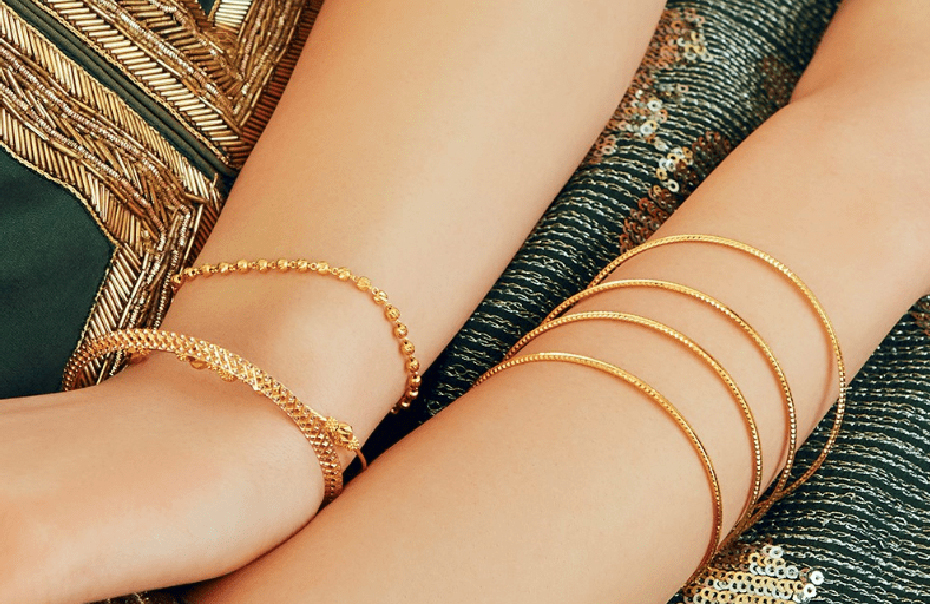Bangles and their essence
The name Bangle has been derived from the word ‘bungri’ which means glass. It is believed that glass bangles tend to bring safety and luck to one’s life. Bangles fall in the category of wrist ornaments, and basically are rigid and circular structures that beautifully enhance the wrists of the wearer. Bangles are crafted in a variety of designs and styles, each one of them having a significant meaning and traditional importance of their own. Depending on the occasion, sometimes they are layered together and other times are independently worn in both hands. For ages, artisans and karigars have been crafting bangles in various materials like gold, silver, wood, glass, ivory, terracotta and embellished with stones, shells, copper, glass, etc and in today’s time, we can witness these ornaments being incorporated in furthermore diverse materials like precious metals, fabrics, plastic, etc along with the above.

Bangles, the rooted history and the story behind them.
The importance of wearing Bangles was not just limited to occasions or weddings but has been an essential part of the daily lives of men and women for ages. The practice of wearing bangles has been given great importance in various classical Indian dance forms as well.
British archaeologists, during the process of an archaeological excavation of Mohenjo-Daro in the year 1973, discovered a female figurine. This female statue was 4,500-year-old and was named the “Dancing Girl” because of her posture. The sculptor carved the beautiful figurine in a way that portrays her wearing nothing but only bangles in one arm. This arm was entirely embellished with bangles clearly pointing towards the fact that bangles have been meaningful essentials and probably the most significant ornaments from ages ago.
Deeply rooted in our culture and with major traditional importance, these hand ornaments were worn by the majority of women all over South Asia along with a handful of men. Along with a few other ornaments, bangles were considered to be an important part of the everyday extravagant attires of both the male and female members of the royal family. From then to the present day, they have been passed on through generations and still hold great significance and essence in the everyday lives of women, majorly in countries like India, Nepal, Pakistan, and Bangladesh.

In the modern-day, the tradition of adorning bangles is no longer limited to the native countries of origin. Rather they have become staples for women and men in the Western countries too. The only difference lies in what meaning they hold in the lives of the wearer. Unlike the native wearers of South Asia who wear bangles due to their cultural significance, women and men in the west wear them as accessories due to their aesthetic significance and gorgeous design.
Traditional Significance
It is pretty clear from the above that bangles have been essentially a huge part of the lives of both men and women from ages with significant traditional relevance of their own. Different styles and types of bangles mark different occasions, what’s interesting is that even the material in which the bangle has been made is specific to occasions.
Bangles and their essenceThe name Bangle has been derived from the word ‘bungri’ which means glass. It is believed that glass bangles tend to bring safety and luck to one’s life. Bangles fall in the category of wrist ornaments, and basically are rigid and circular structures that beautifully enhance the wrists of the wearer. Bangles are crafted in a variety of designs and styles, each one of them having a significant meaning and traditional importance of their own. Depending on the occasion, sometimes they are layered together and other times are independently worn in both hands. For ages, artisans and karigars have been crafting bangles in various materials like gold, silver, wood, glass, ivory, terracotta and embellished with stones, shells, copper, glass, etc and in today’s time, we can witness these ornaments being incorporated in furthermore diverse materials like precious metals, fabrics, plastic, etc along with the above.

Here are some FAQs that you wouldn’t want to miss out on:
How many types of bangles are there?
When it comes to hand ornaments, bangles are one of the many accessories. There are endless number of designs and styles that one can find when looking for their ideal bangle designs but they are majorly divided into three broad categories mentioned further.

Solid Cylinder Bangles: These types of solid cylinder bangles are the most popular and perhaps the oldest ones. These solid bangles are basically continuous cylindrical structures that run smoothly without any joints or hindrances and can be effortlessly slid through one’s wrist.

SPLIT CYLINDER BANGLES: As the name suggests, the split cylindrical bangles go around one’s wrist covering 365° but are split into two parts with an opening and a closing mechanism added to the edges. This feature allows for a better silhouette and a snugger fit. The split cylinder bangles are also popularly known as cylindrical spring bangles.

CUFF BANGLES: Cuff bangles are a bold and modern take on the traditional cylindrical bangle. These are way more experimental than the traditional cylindrical bangles. With more emphasis on design, aesthetics and ergonomics, cuff bangles tend to have a better structure and design along with increased sturdiness. They don’t need an occasion, rather they can be diversely and effortlessly carried. Their structure isn’t defined; they could be circular, ovalish or in other shapes with an opening on the back, the side or even on the front for that matter.
How many types of bangles are there?
This method is helpful if you want to find out the measurement of your existing bangle in order to compare it with the ones you are looking to purchase. To measure the size of your existing bangle, take a scale and put it over the bangle in a way that it covers it fully, horizontally. Now mark the opposite points where the scale touches the bangle along its inner edges so that you can find out the measurement of its inner diameter. Always try to measure the bangle’s inner diameter in millimeters to ensure accuracy and you can further convert it into any other unit if needed. Once you have, just evaluate the numbers with the table that follows.
| Bangle Size (Indian) | Diameter (Inches) | Diameter (MM) |
|---|---|---|
| 2-2 | 2.12 | 54 |
| 2-4 | 2.25 | 57.2 |
| 2-6 | 2.37 | 60.3 |
| 2-8 | 2.5 | 63.5 |
| 2-10 | 2.62 | 66.7 |
| 2-12 | 2.75 | 69.9 |
| 2-14 | 2.87 | 73 |
| 3 | 3 | 76.3 |
To ascertain your wrist size, all you would need is a measuring tape or a simple thread along with a ruler. Once you have the above-listed things with you, fold your wrist in a way that your thumb and the little finger come together. Hold that position while you measure along the widest part of your hand with the help of a measuring tape or a thread. If you used a measuring tape, you would have the numbers in front of you that can be further evaluated against the chart provided below and on the other hand, if you used a thread instead, just place it against the ruler to get the exact length and further evaluate the same against the chart provided ahead. The above steps therefore would help you get your bangle size.

| Bangle Size (Indian) | Circumference (Inches) | Circumference (MM) |
|---|---|---|
| 2-2 | 6.68 | 169.7 |
| 2-4 | 7.07 | 179.6 |
| 2-6 | 7.46 | 189.5 |
| 2-8 | 7.85 | 199.4 |
| 2-10 | 8.24 | 209.3 |
| 2-12 | 8.64 | 219.5 |
| 2-14 | 9.03 | 229.4 |
| 3 | 9.42 | 239.3 |
How to reduce bangle size?
Although it is always better to measure and find your exact bangle size before making a purchase, people often tend to go for sizes that do not compliment their wrists and therefore we are often asked about how to reduce the size of the bangle.
To get your bangle size reduced, you can find a jewellery craftsman nearby and share your exact measurements with them. Further, you could get the bangle size reduced by getting the extra length cut out from the bangle and then getting the edges soldered back together. Once done, the bangle would need a few finishing touches and would be perfect for you to wear.
What is the average size of a bangle bracelet?
When not sure about what size of bangle to buy, it is safer to opt for the standard size of bangle. Standard size or average size is the one that is the most popular amongst the majority of women. The average bangle size is between 7 to 7.5 inches. The bangle should sit between your wrist bone at the base of your hand.
Are ladies’ bangles all one size?
There are numerous designs and shapes of bangles as per personal preferences of the wearers, just like that the sizes too vary from one person to another. Therefore the size of the bangles made for your wrist would differ from the sizes that would have been made for other wrists.









